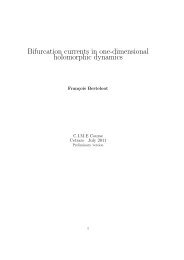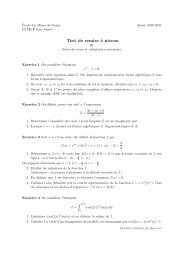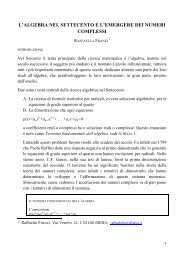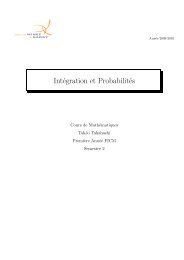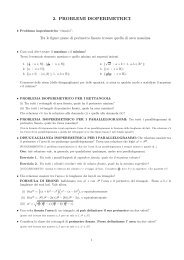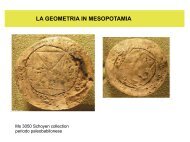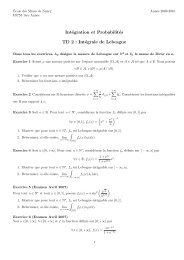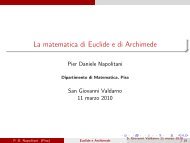Derivation of a fundamental diagram for urban traffic flow
Derivation of a fundamental diagram for urban traffic flow
Derivation of a fundamental diagram for urban traffic flow
Create successful ePaper yourself
Turn your PDF publications into a flip-book with our unique Google optimized e-Paper software.
8 The European Physical Journal B<br />
As Figure 3 shows, the delay time by each <strong>of</strong> the n s additional<br />
stops is (1−u 0 max<br />
i )Tcyc . Moreover, we can see that the<br />
triangular part <strong>of</strong> the vehicle queue in the space-time plot<br />
gives a further contribution to the delay time <strong>of</strong> vehicles.<br />
Applying equation (20) withf i = u i = u 0 i , the average<br />
time delay in this triangular part is (1 − u 0 max<br />
i )Tcyc /2, i.e.<br />
the arithmetic average between zero and the sum <strong>of</strong> the<br />
red and amber time period (amounting to (1 − u 0 max<br />
i )Tcyc ).<br />
In summary, the delay time <strong>of</strong> a newly arriving vehicle at<br />
time t (when averaging over the triangular part <strong>for</strong> the<br />
sake <strong>of</strong> simplicity), is<br />
max ⌊ ⌋<br />
Ti<br />
av (u i ,t)=(1− u 0 cyc ui (t − t i0 )<br />
i )T +<br />
2 u 0 i T cyc<br />
max (1 − u 0 max<br />
i )Tcyc<br />
( ⌊ ⌋)<br />
1<br />
=<br />
2 + ui (t − t i0 )<br />
u 0 i T cyc<br />
max (1 − u 0 i )Tcyc max . (60)<br />
Accordingly, the average travel time does not only grow<br />
with time t (or the number k <strong>of</strong> cycles passed), it also<br />
grows stepwise due to the floor function ⌊x⌋.<br />
When we also average <strong>for</strong>mula (60) over its steps, we<br />
obtain the approximate relationship<br />
( )<br />
Ti<br />
av ui (t − t i0 )<br />
(u i ,t) ≈<br />
u 0 i T cyc<br />
max (1 − u 0 max<br />
i )Tcyc<br />
= u i (t − t i0 ) (1 − u0 i )<br />
u 0 , (61)<br />
i<br />
where it is important to consider that the floor function<br />
⌊x⌋ is shifted by 0.5 with respect to the function round(x),<br />
which rounds to the closest integer: round(x) =⌊x +0.5⌋.<br />
Moreover, when averaging over the last (k +1st) cycle<br />
we get<br />
(<br />
Ti av (u i ,k) ≈ u i k + 1 ) 1 − u<br />
0<br />
i<br />
2 u 0 Tcyc max . (62)<br />
i<br />
It is also possible to replace the dependence on the number<br />
k <strong>of</strong> cycles by a dependence on the average density <strong>of</strong><br />
delayed vehicles by applying equation (55). In this way,<br />
we obtain<br />
k + 1 2 = ΔNi<br />
av (u i , {u 0 j },k)<br />
(u i − u 0 i ) ̂Q i Tcyc max ({u 0 j }) − u0 i (1 − u i)<br />
2(u i − u 0 (63)<br />
i ).<br />
There<strong>for</strong>e, while in Section 3 we could express the average<br />
travel time and the average velocity either in dependence<br />
<strong>of</strong> the average density ρ av<br />
i or the utilization u i alone, we<br />
now have a dependence on both quantities.<br />
Finally note that equations (60) to(62) maybegeneralized<br />
to the case where the arrival rate <strong>of</strong> vehicles is<br />
not time-independent. This changes the triangular part <strong>of</strong><br />
Figure 3. In order to reflect this, the corresponding contribution<br />
(1 − u 0 max<br />
i )Tcyc /2 may, again, be multiplied with<br />
aprefactor(1− ɛ i ), which defines an efficiency ɛ i . While<br />
ɛ i = 0 corresponds to the previously discussed case <strong>of</strong> an<br />
uni<strong>for</strong>m arrival <strong>of</strong> vehicles, ɛ i = 1 reflects the case where a<br />
densely packed platoon <strong>of</strong> vehicles arrives at the moment<br />
when the last vehicle in the queue has started to move<br />
<strong>for</strong>ward.<br />
5 Fundamental relationships<br />
<strong>for</strong> oversaturated <strong>traffic</strong> conditions<br />
We have seen that, under congested conditions, the number<br />
<strong>of</strong> delayed vehicles is growing on average. Hence, the<br />
vehicle queue will eventually fill the road section reserved<br />
<strong>for</strong> vehicle stream i completely. Its maximum storage capacity<br />
per lane <strong>for</strong> delayed vehicles is<br />
ΔN jam<br />
i (L i )=L i ρ jam<br />
i , (64)<br />
where ρ jam<br />
i denotes the maximum density <strong>of</strong> vehicles per<br />
lane. The road section becomes completely congested at<br />
the time<br />
t = t i0 + kTcyc max + Δt, (65)<br />
when ΔNi min (u i ,k)+A i Δt according to equation (53)<br />
reaches the value ΔN jam<br />
i , which implies<br />
where<br />
Δt =<br />
ΔN<br />
jam<br />
i<br />
⌊<br />
k =<br />
(u i − u 0 i<br />
− ΔNi<br />
min (u i ,k)<br />
, (66)<br />
A i<br />
ΔN jam<br />
i<br />
)T<br />
max<br />
cyc<br />
⌋<br />
, (67)<br />
see equation (53). The number n s + 1 <strong>of</strong> stops is given by<br />
equation (59). See Figure 4 <strong>for</strong> an illustration.<br />
Complete congestion causes spillover effects and obstructs<br />
the arrival <strong>of</strong> upstream vehicles, even though the<br />
green phase would, in principle, allow them to depart.<br />
When these spill-over effects set in, we are in the oversaturated<br />
regime, and only a certain fraction σ i <strong>of</strong> the<br />
green phase <strong>of</strong> duration u 0 i T cyc<br />
max can be used, where 0 ≤<br />
σ i ≤ 1. Note that σ i decreases in time as the number <strong>of</strong><br />
blocked subsequent road sections grows. This may eventually<br />
lead to gridlock in a large area <strong>of</strong> the <strong>urban</strong> <strong>traffic</strong><br />
system.<br />
In the case σ i < 1, f i = u 0 i must essentially be replaced<br />
by f i = σ i u 0 i in the <strong>fundamental</strong> relationships <strong>for</strong><br />
congested <strong>traffic</strong>, and the lost service time becomes<br />
T los = ∑ [<br />
]<br />
τ i +(1− σ i )u 0 i Tcyc<br />
max . (68)<br />
i<br />
That is, the reduced service time may be imagined like an<br />
extension <strong>of</strong> the amber time periods. There<strong>for</strong>e, it would<br />
make sense to reduce the cycle time to a value T cyc



